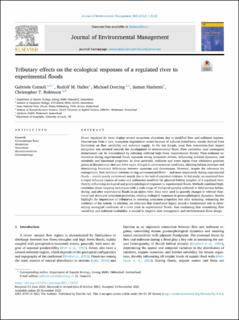Please use this identifier to cite or link to this item:
https://doi.org/10.21256/zhaw-23917Full metadata record
| DC Field | Value | Language |
|---|---|---|
| dc.contributor.author | Consoli, Gabriele | - |
| dc.contributor.author | Haller, Rudolf M | - |
| dc.contributor.author | Doering, Michael | - |
| dc.contributor.author | Hashemi, Saman | - |
| dc.contributor.author | Robinson, Christopher T | - |
| dc.date.accessioned | 2022-01-14T13:21:01Z | - |
| dc.date.available | 2022-01-14T13:21:01Z | - |
| dc.date.issued | 2022-02-01 | - |
| dc.identifier.issn | 0301-4797 | de_CH |
| dc.identifier.issn | 1095-8630 | de_CH |
| dc.identifier.uri | https://digitalcollection.zhaw.ch/handle/11475/23917 | - |
| dc.description.abstract | Rivers regulated by dams display several ecosystem alterations due to modified flow and sediment regimes. Downstream from a dam, ecosystem degradation occurs because of reduced disturbance, mostly derived from limitations on flow variability and sediment supply. In the last decade, most flow restoration/dam impact mitigation was oriented towards the development of environmental flows. Flow variability (and consequent disturbance) can be reintroduced by releasing artificial high flows (experimental floods). Flow-sediment interactions during experimental floods represent strong ecosystem drivers, influencing nutrient dynamics, and metabolic and functional properties. In river networks, sediment and water inputs from tributaries generate points of discontinuity that can drive major changes in environmental conditions, affecting habitat structure and determining functional differences between upstream and downstream. However, despite the relevance for management, flow/sediment relations during environmental flows - and more importantly during experimental floods - remain poorly understood, mostly due to the lack of empirical evidence. In this study, we examined how a major tributary (source of water and sediments) modified the physical habitat template of a regulated river, thereby influencing ecological and geomorphological responses to experimental floods. Methods combined high-resolution drone mapping techniques with a wide range of biological samples collected in field surveys before, during, and after experimental floods in an alpine river. Data were used to quantify changes in relevant functional and structural ecosystem properties, relating ecological responses to geomorphological dynamics. Results highlight the importance of tributaries in restoring ecosystem properties lost after damming, enhancing the resilience of the system. In addition, we observed that disturbance legacy played a fundamental role in determining ecological conditions of a river prior to experimental floods, thus confirming that considering flow variability and sediment availability is crucial in adaptive dam management and environmental flows design. | de_CH |
| dc.language.iso | en | de_CH |
| dc.publisher | Elsevier | de_CH |
| dc.relation.ispartof | Journal of Environmental Management | de_CH |
| dc.rights | http://creativecommons.org/licenses/by/4.0/ | de_CH |
| dc.subject | Disturbance | de_CH |
| dc.subject | Environmental flow | de_CH |
| dc.subject | Geomorphology | de_CH |
| dc.subject | Macroinvertebrates | de_CH |
| dc.subject | Metabolism | de_CH |
| dc.subject | River | de_CH |
| dc.subject | Unmanned aerial device | de_CH |
| dc.subject | Water | de_CH |
| dc.subject | Ecosystem | de_CH |
| dc.subject | Flood | de_CH |
| dc.subject.ddc | 333: Bodenwirtschaft und Ressourcen | de_CH |
| dc.subject.ddc | 551: Geologie und Hydrologie | de_CH |
| dc.title | Tributary effects on the ecological responses of a regulated river to experimental floods | de_CH |
| dc.type | Beitrag in wissenschaftlicher Zeitschrift | de_CH |
| dcterms.type | Text | de_CH |
| zhaw.departement | Life Sciences und Facility Management | de_CH |
| zhaw.organisationalunit | Institut für Umwelt und Natürliche Ressourcen (IUNR) | de_CH |
| dc.identifier.doi | 10.1016/j.jenvman.2021.114122 | de_CH |
| dc.identifier.doi | 10.21256/zhaw-23917 | - |
| dc.identifier.pmid | 34838387 | de_CH |
| zhaw.funding.eu | No | de_CH |
| zhaw.issue | 114122 | de_CH |
| zhaw.originated.zhaw | Yes | de_CH |
| zhaw.publication.status | publishedVersion | de_CH |
| zhaw.volume | 303 | de_CH |
| zhaw.publication.review | Peer review (Publikation) | de_CH |
| zhaw.webfeed | Ökohydrologie | de_CH |
| zhaw.funding.zhaw | Monitoring künstliche Hochwasser an der Sarine | de_CH |
| zhaw.author.additional | No | de_CH |
| zhaw.display.portrait | Yes | de_CH |
| Appears in collections: | Publikationen Life Sciences und Facility Management | |
Files in This Item:
| File | Description | Size | Format | |
|---|---|---|---|---|
| 2022_Consoli-etal_Tributary-effects-ecological-responses-flood.pdf | 5.73 MB | Adobe PDF |  View/Open |
Show simple item record
Consoli, G., Haller, R. M., Doering, M., Hashemi, S., & Robinson, C. T. (2022). Tributary effects on the ecological responses of a regulated river to experimental floods. Journal of Environmental Management, 303(114122). https://doi.org/10.1016/j.jenvman.2021.114122
Consoli, G. et al. (2022) ‘Tributary effects on the ecological responses of a regulated river to experimental floods’, Journal of Environmental Management, 303(114122). Available at: https://doi.org/10.1016/j.jenvman.2021.114122.
G. Consoli, R. M. Haller, M. Doering, S. Hashemi, and C. T. Robinson, “Tributary effects on the ecological responses of a regulated river to experimental floods,” Journal of Environmental Management, vol. 303, no. 114122, Feb. 2022, doi: 10.1016/j.jenvman.2021.114122.
CONSOLI, Gabriele, Rudolf M HALLER, Michael DOERING, Saman HASHEMI und Christopher T ROBINSON, 2022. Tributary effects on the ecological responses of a regulated river to experimental floods. Journal of Environmental Management. 1 Februar 2022. Bd. 303, Nr. 114122. DOI 10.1016/j.jenvman.2021.114122
Consoli, Gabriele, Rudolf M Haller, Michael Doering, Saman Hashemi, and Christopher T Robinson. 2022. “Tributary Effects on the Ecological Responses of a Regulated River to Experimental Floods.” Journal of Environmental Management 303 (114122). https://doi.org/10.1016/j.jenvman.2021.114122.
Consoli, Gabriele, et al. “Tributary Effects on the Ecological Responses of a Regulated River to Experimental Floods.” Journal of Environmental Management, vol. 303, no. 114122, Feb. 2022, https://doi.org/10.1016/j.jenvman.2021.114122.
Items in DSpace are protected by copyright, with all rights reserved, unless otherwise indicated.